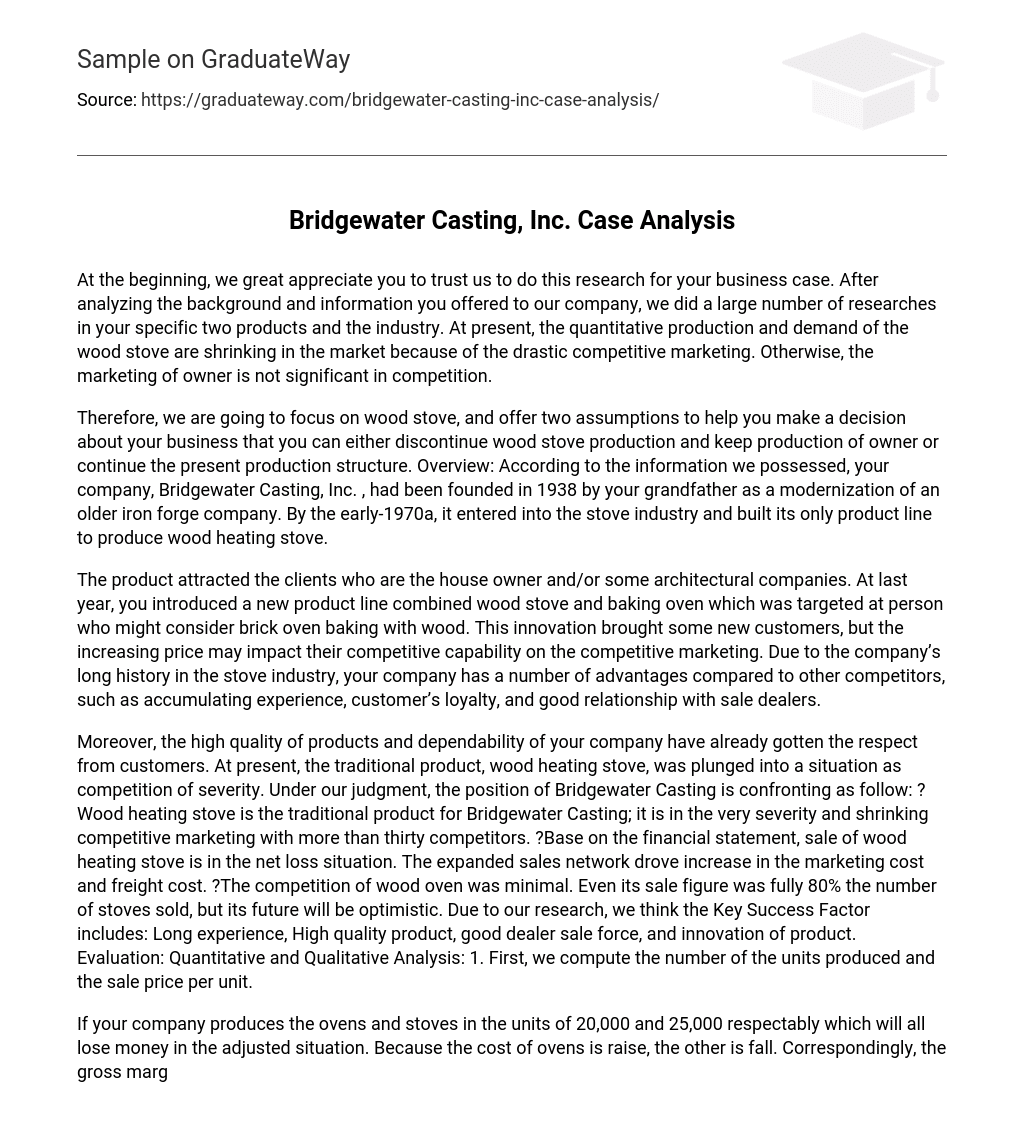Initially, we would like to express our gratitude for entrusting us with the task of conducting research for your business case. After examining the provided background information, we extensively researched your two specific products and the industry as a whole. Currently, the market for wood stoves is experiencing a decline in both production and demand due to intense competition. Additionally, the owner’s marketing efforts are not making a significant impact in this competitive landscape.
Therefore, we will focus on wood stoves and provide two assumptions for your business decision: either stop wood stove production and continue producing other products, or continue with the current production structure. Overview: Bridgewater Casting, Inc., your company, was established in 1938 by your grandfather to modernize an older iron forge company. By the early 1970s, it ventured into the stove industry and developed a product line specifically for manufacturing wood heating stoves.
The product appealed to both homeowners and architectural companies. Last year, a new product line was introduced that combined a wood stove and baking oven, specifically targeting individuals interested in brick oven baking with wood. This innovation attracted new customers, but the rising price could potentially impact their competitiveness in the market. However, due to the company’s extensive history in the stove industry, it possesses several advantages over its competitors, including accumulated experience, customer loyalty, and strong relationships with sales dealers.
In addition, your company has already gained the respect of customers due to the high quality of products and dependability. Currently, the traditional product, wood heating stove, is facing intense competition. In our assessment, Bridgewater Casting is facing the following challenges:
– Wood heating stove, being a traditional product for Bridgewater Casting, faces severe competition from over thirty competitors.
– According to the financial statement, sales of wood heating stoves are experiencing a net loss. The increase in the sales network has led to higher marketing and freight costs.
– The competition for wood ovens is minimal, and although its sales figure is 80% of the number of stoves sold, its future looks promising. Our research indicates that the Key Success Factors include long experience, high quality product, strong dealer sales force, and product innovation.
Evaluation: We will conduct quantitative and qualitative analysis, starting with calculating the number of units produced and the sale price per unit.
If your company produces 20,000 ovens and 25,000 stoves, both will experience losses. This is due to the rising cost of ovens and the falling cost of stoves. Consequently, the gross margin for ovens decreases while it increases for stoves. Despite a decrease in the cost of goods sold through adjusted distribution, profits for stoves are still lost due to their high initial cost. Therefore, we recommend that your company avoid making this decision.
Originally, the production of 20,000 and 25,000 units in ovens and stoves resulted in financial losses. However, we are now attempting to modify the outcomes.
Let ovens be expanded to 30,000 units and constrain stoves to 15,000 units. Despite stoves still experiencing more losses after decreasing the units, your company ultimately achieves a profit of $5000. Consequently, we recommend that your company focuses on producing only one product – ovens – with a production of 30,000 units. As for stoves, we regretfully advise shutting down production. 6. Only oven: displays the costs and profits of ovens in both the adjusted and unadjusted scenarios at 30,000 units.
Our proposal is to adopt the adjusted ovens in 30,000 units for your company. However, there is a difference in the costs of goods sold between the adjusted ovens and the original ones. The adjusted ovens have lower costs, while the original ones have slightly higher costs. Other costs remain unchanged. Based on the same number of units, we observe that the profit from the adjusted ovens is $583,000, whereas the profit from the original ones is $280,000.
The first one has generated a higher profit of $303,000 compared to the original. Hence, we view this as the optimal approach to sustain the company’s operations. Recommendation: Based on recent accounting records, we suggest discontinuing the stove business as it is currently experiencing losses and poses a significant threat to the company’s future. Moreover, this could also impact the oven business. Therefore, it would be more beneficial for the company to solely focus on the oven sector and discontinue stove operations.
This allows the company and its employees to concentrate on the main aspect, which will help management increase oven sales. Additionally, the advantages of selling ovens, such as higher profit margins and innovative concepts, will motivate the company to sell more. This means that a higher selling price results in a higher sales commission, encouraging salespeople to strive for greater sales. Therefore, it is recommended that the company cease stove production and prioritize oven production and sales. The following steps need to be taken:
The company’s main focus is on expanding the oven market. Currently, the average number of oven orders is only two units. However, it appears that we will continue to be in the oven product line for the foreseeable future, and both units are generating positive profit contribution. The company’s goal is to sell 30,000 units annually in order to earn enough profit and cover the net loss from before. To achieve this, we will advertise through the internet and TV shows to reach more customers and make them aware of our product. Additionally, it is rational to establish relationships with dealers and agencies in new regions to facilitate the expansion of our marketing efforts.





